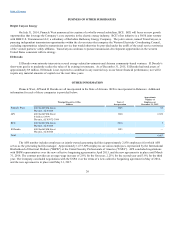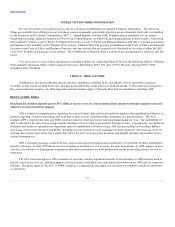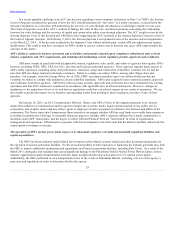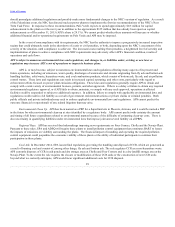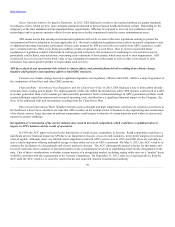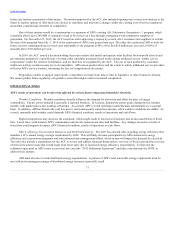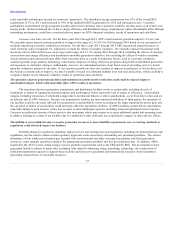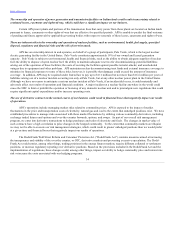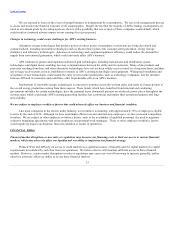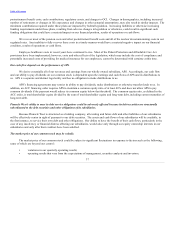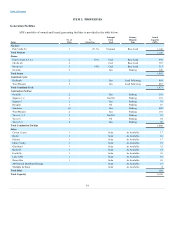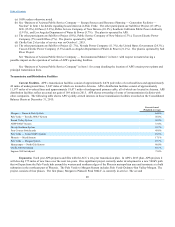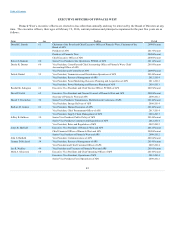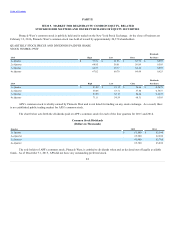APS 2015 Annual Report Download - page 38
Download and view the complete annual report
Please find page 38 of the 2015 APS annual report below. You can navigate through the pages in the report by either clicking on the pages listed below, or by using the keyword search tool below to find specific information within the annual report.
Table of Contents
We are exposed to losses in the event of nonperformance or nonpayment by counterparties. We use a risk management process
to assess and monitor the financial exposure of all counterparties. Despite the fact that the majority of APS’s trading counterparties are
rated as investment grade by the rating agencies, there is still a possibility that one or more of these companies could default, which
could result in a material adverse impact on our earnings for a given period.
Changes in technology could create challenges for APS’s existing business.
Alternative energy technologies that produce power or reduce power consumption or emissions are being developed and
commercialized, including renewable technologies such as photovoltaic (solar) cells, customer-sited generation, energy storage
(batteries), and efficiency technologies. Advances in technology and equipment/appliance efficiency could reduce the demand for
supply from conventional generation, which could adversely affect APS’s business.
APS continues to pursue and implement advanced grid technologies, including transmission and distribution system
technologies and digital meters enabling two-way communications between the utility and its customers. Many of the products and
processes resulting from these and other alternative technologies have not yet been widely used or tested on a long-term basis, and their
use on large-scale systems is not as established or mature as APS’s existing technologies and equipment. Widespread installation and
acceptance of new technologies could enable the entry of new market participants, such as technology companies, into the interface
between APS and its customers and could have other unpredictable effects on APS’s business.
Deployment of renewable energy technologies is expected to continue across the western states and result in a larger portion of
the overall energy production coming from these sources. These trends, which have benefited from historical and continuing
government subsidies for certain technologies, have the potential to put downward pressure on wholesale power prices throughout the
western states which could make APS's existing generating facilities less economical and impact their operational patterns and long-
term viability.
We are subject to employee workforce factors that could adversely affect our business and financial condition.
Like most companies in the electric utility industry, our workforce is maturing, with approximately 36% of employees eligible
to retire by the end of 2018. Although we have undertaken efforts to recruit and train new employees, we face increased competition
for talent. We are subject to other employee workforce factors, such as the availability of qualified personnel, the need to negotiate
collective bargaining agreements with union employees and potential work stoppages. These or other employee workforce factors
could negatively impact our business, financial condition or results of operations.
FINANCIAL RISKS
Financial market disruptions or new rules or regulations may increase our financing costs or limit our access to various financial
markets, which may adversely affect our liquidity and our ability to implement our financial strategy.
Pinnacle West and APS rely on access to credit markets as a significant source of liquidity and the capital markets for capital
requirements not satisfied by cash flow from our operations. We believe that we will maintain sufficient access to these financial
markets. However, certain market disruptions or rules or regulations may cause our cost of borrowing to increase generally, and/or
otherwise adversely affect our ability to access these financial markets.
35



